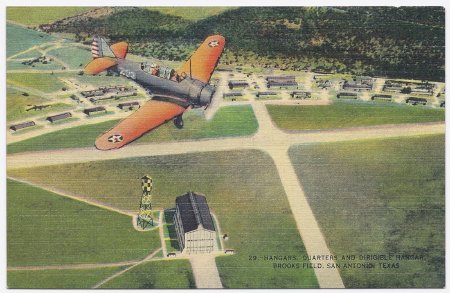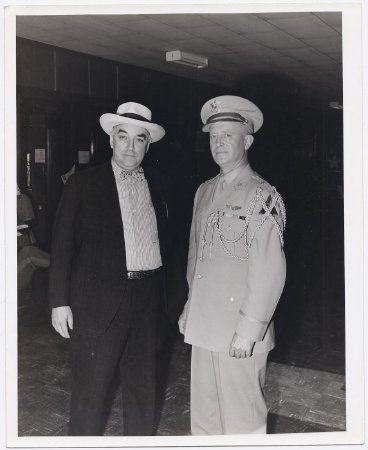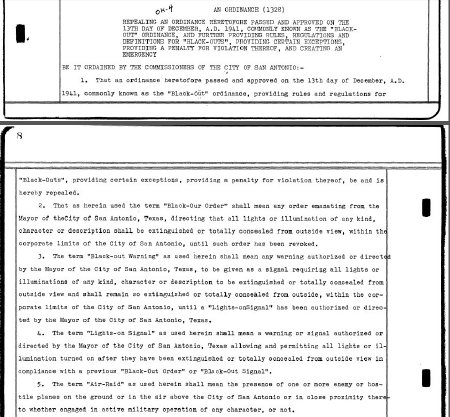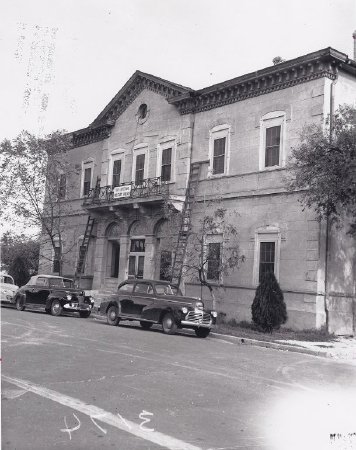Blackout Preparations
History:
As San Antonians soon discovered, the blackouts "involved considerably more than merely turning out all the lights." 3 Preparing for a blackout required a concerted effort not only by city officials, especialliy police and fire, but also by members of the Army Air Corps at Brooks and Kelly Fields, who would provide fly-overs, take photographs, and drop the flares used as mock bombs.4 Fire and Police Commissioner Preston L. Anderson, who was in charge of the fire and police force divisions for defense, coordinated with the military for the simulated air raid. Some of the other 16 civilian defense positions included: air raid wardens, nurses, fire watchers, demolition crew, and drivers' corps. By the night of the blackout, over 15,000 volunteers had registered to assist. 5
During a blackout, residents had to turn off their lights, or cover them so that no light leaked outside. The city's new blackout ordinance also prohibited smoking and lighting matches, since both could be seen in the dark. Any travelling motorists were required to pull over, except for emergency and army vehicles that covered their lights with dark cloth. Blackout wardens watched from tall buildings to note any light or traffic violations, which carried a maximum fine of $200.6 Traffic wardens monitored the traffic, patrolled the streets, and would have blocked off any areas damaged in an actual air raid.7 The blackout regulations extended even beyond the city to the suburbs and the surrounding highways — all the way to Seguin, Boerne, Floresville and Pleasanton — to prevent a ring of light, or travelling cars, from giving away San Antonio's location to enemy planes.
During a blackout, residents had to turn off their lights, or cover them so that no light leaked outside. The city's new blackout ordinance also prohibited smoking and lighting matches, since both could be seen in the dark. Any travelling motorists were required to pull over, except for emergency and army vehicles that covered their lights with dark cloth. Blackout wardens watched from tall buildings to note any light or traffic violations, which carried a maximum fine of $200.6 Traffic wardens monitored the traffic, patrolled the streets, and would have blocked off any areas damaged in an actual air raid.7 The blackout regulations extended even beyond the city to the suburbs and the surrounding highways — all the way to Seguin, Boerne, Floresville and Pleasanton — to prevent a ring of light, or travelling cars, from giving away San Antonio's location to enemy planes.
About this Image:
1) A postcard featuring a plane flying over Brooks Field. Many of the airplane hangars are visible in the background, but the historic WWI Hangar 9 takes center stage.
2) Commissioner P.L. Anderson stands with Brigadier General C.L. Mullins, Jr. of the 11th Armored Division in a building at Alamo Field (now the San Antonio International Airport).
3) Pages from the original "blackout ordinance" passed by the City in 1941. The ordinance lists the various rules and fines in place for the blackout. The entire document can be found on the San Antonio Office of the City Clerk's website.
4) The French-style Francois Guilbeau House at 500 Main Avenue became an unlikely police headquarters. In 1941, the City purchased the 1847 building to house the local military police (MPs), whose station at Fort Sam was being repurposed. Not wanting to lose the services of the MPs as a supplement to the city police force, the City paid $2500 to buy the building for them and an additional $2500 to remodel it. The City had agreed that the Guilbeau House would become a museum after the war, but sold it to developer Morris Kallison instead. By 1951, its poor condition sealed its fate and it was razed.8 Credit: L-3174-A, University of Texas at San Antonio Libraries Special Collections. Institute of Texan Cultures.
2) Commissioner P.L. Anderson stands with Brigadier General C.L. Mullins, Jr. of the 11th Armored Division in a building at Alamo Field (now the San Antonio International Airport).
3) Pages from the original "blackout ordinance" passed by the City in 1941. The ordinance lists the various rules and fines in place for the blackout. The entire document can be found on the San Antonio Office of the City Clerk's website.
4) The French-style Francois Guilbeau House at 500 Main Avenue became an unlikely police headquarters. In 1941, the City purchased the 1847 building to house the local military police (MPs), whose station at Fort Sam was being repurposed. Not wanting to lose the services of the MPs as a supplement to the city police force, the City paid $2500 to buy the building for them and an additional $2500 to remodel it. The City had agreed that the Guilbeau House would become a museum after the war, but sold it to developer Morris Kallison instead. By 1951, its poor condition sealed its fate and it was razed.8 Credit: L-3174-A, University of Texas at San Antonio Libraries Special Collections. Institute of Texan Cultures.
To Learn More:
Credit:
Courtesy of San Antonio Conservation Society Foundation




